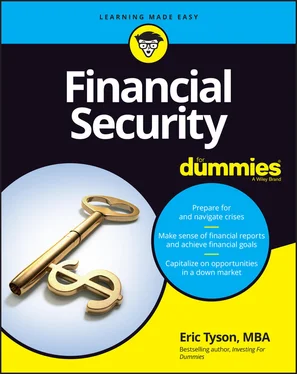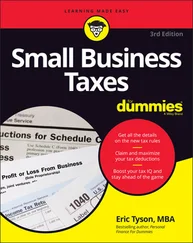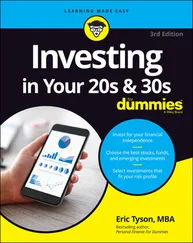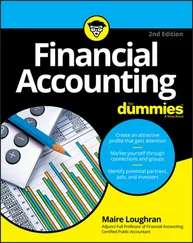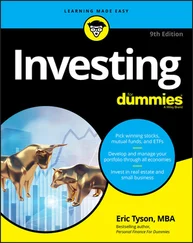1 Chapter 2 TABLE 2-1: Annual GDP Change for the United States
2 Chapter 11TABLE 11-1 Chronic Conditions Affecting Activity
1 Chapter 6FIGURE 6-1: A drop in GDP followed by recovery. FIGURE 6-2: GDP trend from 1948 to present. FIGURE 6-3: An example of a payroll survey. FIGURE 6-4: Labor force participation rate. FIGURE 6-5: University of Michigan Consumer Sentiment. FIGURE 6-6: Overall versus core CPI.
2 Chapter 11FIGURE 11-1: Insurance needs worksheet.
1 Cover
2 Title Page
3 Copyright
4 Table of Contents
5 Begin Reading
6 Index
7 About the Author
1 iii
2 iv
3 1
4 2
5 3
6 5
7 6
8 7
9 8
10 9
11 10
12 11
13 12
14 13
15 14
16 15
17 17
18 18
19 19
20 20
21 21
22 22
23 23
24 24
25 25
26 26
27 27
28 28
29 29
30 30
31 31
32 32
33 33
34 34
35 35
36 36
37 37
38 39
39 40
40 41
41 42
42 43
43 44
44 45
45 46
46 47
47 48
48 49
49 50
50 51
51 53
52 54
53 55
54 56
55 57
56 58
57 59
58 60
59 61
60 62
61 63
62 64
63 65
64 66
65 67
66 68
67 69
68 70
69 71
70 72
71 73
72 74
73 75
74 76
75 77
76 78
77 79
78 80
79 81
80 82
81 83
82 84
83 85
84 86
85 87
86 88
87 89
88 90
89 91
90 92
91 93
92 94
93 95
94 96
95 97
96 98
97 99
98 100
99 101
100 102
101 103
102 104
103 105
104 106
105 107
106 109
107 110
108 111
109 112
110 113
111 114
112 115
113 116
114 117
115 118
116 119
117 120
118 121
119 122
120 123
121 124
122 125
123 126
124 127
125 128
126 129
127 130
128 131
129 132
130 133
131 134
132 135
133 136
134 137
135 138
136 139
137 140
138 141
139 142
140 143
141 144
142 145
143 146
144 147
145 148
146 149
147 150
148 151
149 152
150 153
151 154
152 155
153 156
154 157
155 158
156 159
157 160
158 161
159 162
160 163
161 164
162 165
163 166
164 167
165 168
166 169
167 170
168 171
169 172
170 173
171 174
172 175
173 176
174 177
175 178
176 179
177 180
178 181
179 182
180 183
181 184
182 185
183 186
184 187
185 188
186 189
187 190
188 191
189 192
190 193
191 195
192 196
193 197
194 198
195 199
196 200
197 201
198 202
199 203
200 204
201 205
202 206
203 207
204 208
205 209
206 210
207 211
208 212
209 213
210 214
211 215
212 216
213 217
214 218
215 219
216 220
217 221
218 222
219 223
220 224
221 225
222 226
223 227
224 228
225 229
226 230
227 231
228 232
229 233
230 234
231 235
232 236
233 237
234 238
235 239
236 241
237 242
238 243
239 244
240 245
241 246
242 247
243 248
244 249
245 250
246 251
247 252
248 253
249 254
250 255
251 256
252 257
253 259
254 260
255 261
256 262
257 263
258 264
259 265
260 266
261 267
262 268
263 269
264 270
265 271
266 272
267 273
268 274
269 275
270 276
271 277
272 278
273 279
274 280
275 281
276 283
277 285
278 286
279 287
Welcome to Financial Security For Dummies!
I know from my work as a personal financial counselor and educator that many Americans lack a sufficient background in the financial basics. My first book in this series, Personal Finance For Dummies, sought to address and help close that gap, and the feedback from that book suggests it clearly has helped.
I’ve seen over time, though, that folks who know many of the basics can still suffer financially at important junctures and when hit by unexpected events. So, this new book, Financial Security For Dummies , is like an advanced version of or a sequel to Personal Finance For Dummies.
Most people value financial security and stability, of course, unless they like danger, risk, and turmoil! Living within your means, saving and investing in wise, proven investments, and securing catastrophic insurance are all keys to sound personal financial management.
Unfortunately, your financial security can be undermined by things outside of your control. Upsetting events can include macro-events like the COVID-19 pandemic (2020) or financial crisis (2008) as well as individual life changes or personal crises, such as job loss, divorce, caring for elderly parents, and so on. Part 1addresses these two major types of crises or catalysts.
You may find that at some point, you need to access funds in the event of a crisis. It should give you peace of mind to know that there are ways to get help. Part 2looks at all crises (economic and personal) and discusses safety nets that people can tap and emergency measures they can implement.
You may be looking to navigate the barrage of information coming at you while an economic crisis is in motion. Part 3contains content that is central to the book and vital for you to understand as you deal with turbulent times.
To maintain financial stability, you need to keep your financial house in order. Part 4identifies the key personal finance tasks and steps to take to maximize your future financial security and minimize problems when disruptions inevitably occur.
What does the future hold? No one knows for sure, but there are ways to be prepared. Part 5delves into discerning what pundits may be telling you about current and future economic issues and finding out how to keep yourself and your finances on track when things look gloomy. It also touches on what future crises may be in store and how to keep your cool.
Whenever I approach writing a book, I consider a particular audience for that book. Because of this, I must make some assumptions about who the readers are and what those readers are looking for. Here are a few assumptions I’ve made about you:
You want the best for you and yours and would like to make the most of your money. While you understand there are no guarantees, you’d like to best prepare your financial situation to weather a wide range of adverse conditions.
You’d like to gain a better understanding about how the financial markets and economy work so you can intelligently process news and information that hits, especially in the midst of a crisis.
You’d like to be positioned to be able to invest at least some of your money when otherwise attractive investments have declined in value.
If any of these descriptions hits home for you, you’ve come to the right place.
Читать дальше
